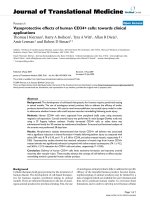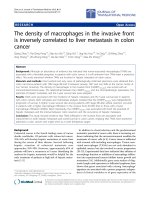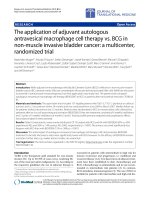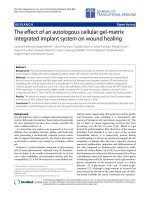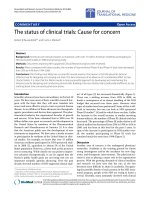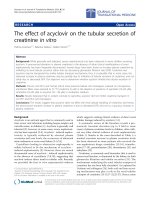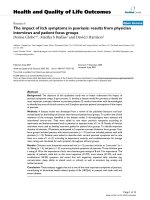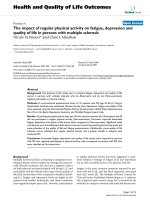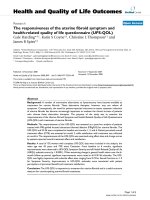Báo cáo hóa học: " The effects of diabetes and/or peripheral neuropathy in detecting short postural perturbations in mature adults" pptx
Bạn đang xem bản rút gọn của tài liệu. Xem và tải ngay bản đầy đủ của tài liệu tại đây (436.7 KB, 10 trang )
RESEARC H Open Access
The effects of diabetes and/or peripheral
neuropathy in detecting short postural
perturbations in mature adults
George D Fulk
1,2*
, Charles J Robinson
2,4,5
, Sumona Mondal
2,3
, Christopher M Storey
6
, Anne M Hollister
7
Abstract
Background: This study explored the effects of diabetes mellitus (DM) and peripheral neuropathy (PN) on the
ability to detect near-threshold postural perturbations.
Methods: 83 subjects participated; 32 with type II DM (25 with PN and 7 without PN), 19 with PN without DM,
and 32 without DM or PN. Peak acceleration thresholds for detecting anterior platform translations of 1 mm,
4 mm, and 16 mm displacements were determined. A 2(DM) × 2(PN) factorial MANCOVA with weight as a
covariate was calculated to compare acceleration detection thresholds among subjects who had DM or did not
and who had PN or did not.
Results: There was a main effect for DM but not for PN. Post hoc analysis revealed that subjects with DM required
higher accelerations to detect a 1 mm and 4 mm displacement.
Conclusion: Our findings suggest that PN may not be the only cause of impaired balance in people with DM.
Clinicians should be aware that diabetes itself might negatively impact the postural control system.
Background
Complications associated with diabetes are linked to
increased postural sway, slowing of peripheral sensory
and motor pathways, abnormal neuromuscular response
to postural disturbance, increased whole body reaction
time, and abnormal gait patterns over irregular surfaces
[1-3]. These complications may lead to impaired pos-
turalcontrolandplayaroleintheincreasedriskof
falling in this population [4].
Various authors have found that individuals with dia-
betes and peripheral neuropathy demonstrate impaired
postural control in quiet standing compared to healthy
control subjects. Boucher and colleagues [1] found that
individuals with diabetes and peripheral neuropathy had
greater postural sway in quiet standing and greater diffi-
culty integrating sensory information for balance control
than healthy control subject s. They also found that pos-
tural control was related to the severity of peripheral
neuropathy. Lafond and colleagues [2]found that
postural sway in elders with diabetes and peripheral
neuropathy with eyes open was comparable to healthy
elders with eyes closed. These studies focused on how
peripheral neuropathy related to diabetes affected pos-
tural control.
Other authors have examined the impact of dia betes
alone on postural c ontrol. In a group of young adults
with insulin dependent diabetes mellitus (IDDM) both
with and without peripheral neuropathy, Uccioli and
colleagues [5] found significant differences in measures
of static postural sway between subjects with IDDM
with peripheral neuropathy an d healthy controls. How-
ever, there was no difference in static postural control
between subjects with IDDM without peripheral neuro-
pathy and healthy controls. Incorporating somatosensory
and motor evoked potentials this same group found that
IDDM might affect both sensory and motor peripheral
pathways, but only sensory pathways centrally [6].
Although peripheral neuropathy is commonly thought
to be the cause of postural instability in people with dia-
betes, there is some evidence that diabetes per se may
have a negative impact on postural control under more
stressful conditions than quiet stance [7-10]. During a
* Correspondence:
1
Department of Physical Therapy, Clarkson University, Potsdam, NY, USA
Full list of author information is available at the end of the article
Fulk et al. Journal of NeuroEngineering and Rehabilitation 2010, 7:44
/>JNER
JOURNAL OF NEUROENGINEERING
AND REHABILITATION
© 2010 Fulk et al; licens ee BioMed Central Ltd. This is an Open Access article distributed under the terms of the Creative Commons
Attribution License ( which permits unrestricted use, distribution, and reproduction in
any medium, provided the origina l work is properly cited.
dynamic reaching task, Centomo and colleagues [9]
found a significant differenc e in measures of postural
control between middle-aged adults with diabetes with-
out peripheral neuropathy and healthy control subjects.
While standing with eyes closed and head back, Oppen-
heim and colleagues [8] found that individuals with dia-
betes without peripheral neuropathy had impaired
postural control compared to healthy individuals.
Recently, Allet and colleagues [7] found that people with
diabetes without peripheral neuropathy demonstrate an
abnormal gait pattern compared to healthy people. They
also found that there was no difference in gait parameters
between diabetics with a nd without peripheral n europa-
thy. Thus, peripheral neuropathy associated with diabetes
may not be the only factor contributing to impaired pos-
tural control in people with diabetes.
Only 30% of people with diabetes have peripheral neu-
ropathy [11,12]. This leaves seventy percent of people
with diabetes who may also demonstrate abnormal pos-
tural control, but may not be identified by clinicians as
having poor balance because they do not have peripheral
neuropathy. Because of the growing evidence that dia-
betes itself may negatively impact balance and increase
fall risk, further research exploring the impact of diabetes
on postural control is necessary. Our lab examine s quasi
static posturography where we deliver via a sophisticated
surface translational platform perturbations that are in
the range of normal postural sw ay Root-Mean-Square
(RMS) path length. In this way we can investigate the
control mechani sms of the postural control system with-
out overtly generating a fall initiating response. We have
previously found that older individuals with diabetes
have a significantly longer reaction time to threshold per-
turbations than individuals without diabetes to anterior
translations [13]. Thus the purpose of this study was to
explore separately and jointly the effects of diabetes and
peripheral neuropathy on the ability of individuals to
detect perithreshold anterior postural perturbations.
Methods
This psychophysical research described here is a part of
an extensive protocol in use in our lab to:
A. Psychophysically determine by iteration the accel-
eration values ( i.e., the detec tion thresholds) at which
fixed-length anterior horizontal platform translations of
1, 4 and 16 mm can be detected; response latencies to
peri-threshold and super-threshold translations; thresh-
olds and reaction times to foot-sole touch; and thresh-
olds and reaction times to tone pulses [13].
B. Biomechanically measure changes in platform posi-
tion and acceleration, and in the center-of-pressure of
the subject as projected onto a force plate, head accel-
eration via a tri-axial accelerometer, and horizontal
ground reaction force.
C. Neurophysiologically measure changes in lower
limb gastroc/soleus and tibialis anterior EMGs brought
about by perturbation.
This paper deals only with the psychophysical part of
the protocol (A above), its methodology and results
from adult subjects at or over 50 years of age.
Subjects
Subjects were recruited through approved flyers posted
in the Overton Brooks VA Hospital in Shreveport,
Louisiana, and the surrounding communities. Approxi-
mately half of the subjects were patients at the VA
hospital and the other half from the surrounding com-
munities. All subjects provided informed consent and
the institutional review boards at the Shreveport
VAMC and Louisiana Tech University approved the
studyprotocol.Thesubject’s primary care physician
made the diagnosis of type II diabetes mellitus and
presence or absence of peripheral neuropathy was
determined by nerve conduction velocity (NCV) testing
(see below for details). Subjects were classified as dia-
betics with peripheral neuropathy (DPN), neurologi-
cally intact diabetics without peripheral neuropathy
(DNI), non-diabetics with PN (PNNoD), and neurolo-
gically intact adults without DM (NInoD). The exact
cause of PN in the subjects without diabetes with PN
was not known.
All subjects underwent a visual, auditory, musculoske-
letal, and cognitive screening to ensure that they had no
undiagnosed condition that may have affected their
balance. Subjects with respiratory dysfunction, cardiac
condition, central nervous system disorder, musculoske-
letal disorder, lower extremity amputation, severe arthri-
tis, history of repeated falls, or currently taking
medication to prevent dizziness were excluded.
Instrument
Balance capability w as measured using the Sliding Lin-
ear Investigative Platform for Assessing L ower Limb
Stability (SLIP-FALLS), a horizontal translating force
platform and data collecti on system [14]. The SLIP-
FALLS platform was specifically designed and built to
assess psychophysical thresholds to postural p erturba-
tions. This highly instrumented platform and its con-
troller enable investigators to precisely control the
platform displacement and acceleration. The use of a
non-contact linear motor and air bearing slides essen-
tially eliminates vibration during movement of the plat-
form, thereby eliminating extraneous cues to the subject
that the platform is being moved. Postural sway para-
meters (anterior-posterior and medial-lateral center of
pressure) are calculated from the four load cells of the
force-platform [15].
Fulk et al. Journal of NeuroEngineering and Rehabilitation 2010, 7:44
/>Page 2 of 10
Procedure
Using an adaptive 2 alternative forced choice (2AFC)
protocol [16], the acceleration thresholds for detecting
an anterior-po sterior, horizontal translation of the plat-
form at displacements of 1 mm, 4 mm, and 16 mm
were determined in separate runs of up to 30 trials
each. Peak platform acceleration was the variable iter-
ated to threshold. During the first half of the move the
platform was smoothly accelerated under precise con-
trol; and in the second half, it was smoothly decelerated,
in both cases so that jerk is minimized. Peak accelera-
tion was programmed to occur one-forth of the way
into the move, zero acceleration at the middle of the
move, and peak deceleration, three quarters into the
move. These smoothed acceleration profile produced a
much subtler move than one that immediately turns on
and maintains a fixed peak acce leration at the start, and
then suddenly reverses it to a fixed peak deceleration
during the second half of the move, with concomitant
high jerk at the beginning, middle and end of the per-
turbation [13,14].
While standing barefoot and blindfolded on the SLIP-
FALLS a subject was presented with the commands
“Ready”, “One” , “ Two”, “Decide” via headphones,
through which masking white noise (70 dB SPL) was
additionally presented. The time intervals for “Ready”
and “Decide” were 4 and 3 s, respectively. For platform
movements of 1 mm and 4 mm, the time interval was 4
s and or the 16 mm platform movement, the time inter-
val was 6 s. During the interval “One” or “Two”,the
platform moved a fixed displacement (1 mm, 4 mm, or
16 mm) at a test accelera tion. After the word “De cide”,
the subject was required (i.e., the choice was forced) to
press a handheld button once or twice t o signify in
which interval he/she perceived the perturbation to have
occurred. Platform movement was pseudo-randomly
assigned to occur in either interval “One” or “Two”,
ensuring that an equal number of platform movements
occurred in each interval.
A modified Parameter Estimation by Sequential Test-
ing (PEST) algorit hm [17,18] was used to determine the
acceleration threshold for perception of movement at a
given displacement (1 mm, 4 mm, and 16 mm). This
algorithm changed the platform a cceleration from one
trial to the next as the acceleration was iterated towards
detection threshold. The modified PEST methodology
ensured that all perturbations were near, or rapidly,
approaching within 30 trials in order to prevent fatigue
[16,18,19]. This technique reduces the number of mea-
surements needed to converge to threshold. The PEST
target probability is set at a level of change rather than
a percentage o f “correct” responses. This protocol was
designed so that an individual subject would accrue a
correct detection percentage of 79% for t est accelera-
tions at t hreshold [16]. In psychophysical testing 75% is
the generally accepted criteria for p sych ophysical detec-
tion [16].
The displacement order (1 mm, 4 mm, or 16 mm) was
randomized. A 10 to 15 minute rest period was taken
after each accel eration threshold was identified at a
fixed displace ment before moving on to the next displa-
cement. For example, after the acceleration threshold
was identified in at most 30 trials at the first test displa-
cement (e.g., 1 mm), the subject rested for 10 to 15
minutes before beginning another 30 trials at a different
displacement (e.g., 4 mm or 16 mm). Figure 1 provides
an overview of the psychophysical 2AFC PEST protocol.
Further details of and justification for the experimental
2AFC PEST psychophysical test paradigm that was
developed for the SLIP-FALLS lab and used here can be
found in Richerson et al [20].
Because the perturbations were very short and accel-
erations well below that employed by any other research
or commercial perturbation platform tests [14], our sub-
jects stood without external support (i.e., safety harness)
during all testing. Because the PEST rules are such that
a series of successive misses in one interval (or corre-
spondingly false posi tives in the other), would lead to
ever increasing acceleration levels, our protocol needed
to limit the maximum peak acceleration that could be
used under a given displacement. These peak (or rail)
levels were originally set to well exceed any threshold
found in our original young adult population. Rails were
set at 200, 100, and 100 mm/s
2
for displacements of 1,
4, and 16 mm respectively. The modifi ed PEST protocol
would not allow acc eleration values to exceed the se
Figure 1 Iterative Protocol for Estimation of the Detection Threshold via the 2-Alternative-Forced Choice and Parameter Estimation by
Sequential Testing Procedures.
Fulk et al. Journal of NeuroEngineering and Rehabilitation 2010, 7:44
/>Page 3 of 10
levels, but if three correct decisions were made in a row,
the algorithm would decrease the test acceleration in
the next trial to a value below the maximum. The r ail
values were thus ceilings that could not be exceeded,
butthatcouldbevisitedbrieflyorfortheremaining
duration of the 30 tri al runs. It became apparent early
in these experiments that a subject’s behavior was such
that we sensed (but could not prove) in some indivi-
duals that threshold was very near or slightly above the
rail values initially used. As such we modified the rail
values to be set to 362, 256, and 181 mm/s
2
(i.e., 2
8.5
,
2
8
,and2
7.5
mm/s
2
) for moves of 1 mm, 4 mm, and
16 mm for all subjects.
Previously our lab has found test-retest reliability for
psychophysical detection of movement with individuals
with and without diabetes using our 2AFC PEST proto-
col described above to be ICC
2,1
to be 0.645 (P < 0.05)
[21]. Intervals between testing ranged from the same
day to two weeks.
In addition to acceleration th reshold detection data
gathered with the SLIPP-FALLS, the following data were
also gathere d for each subject: Berg Balance Scale (BBS)
score, Semmes-Weinstein Monofilament (SWM) touch
detection thresholds, and surface lower-limb nerve con-
duction velocities (NCV). The maximum score on the
Berg is 56; a score below 40 indicates a fall risk. The
Berg has been shown to have excellent interrater (ICC =
0.91) and test-retest (ICC = 0.92) reliability and concur-
rent validity for older individuals [22,23]. No reports
could be found that examined the psychometric proper-
ties of the BBS in people with type II diabetes mellitus.
Sensory testing was performed with SWM on the
plantar surface of the great toe, plantar surface of the
metatarsal of the first and fifth toes, and the heel.
Semmes W einstein monofilaments h ave high reliabi lity
and validity for determining sensory impairment in peo-
ple with diabetes [24,25]. A trained research assistant
performed Berg Balance and SWM testing.
A trained clinical neu rology technician performed sur-
face lower-limb nerve conduction testing in the neurol-
ogy clinical suite, and a neurol ogist supervised and
interpreted the tests. Subjects were classified as having
peripheral neuropathy based on normative data used by
the neurology department at the Pittsburgh VAMC.
Nerve conduction velocities (NCV) were measured for
the tibial, peroneal, and sural nerves bilaterally, and the
thresholds set as abnormal were at or below 41 m/s, 44
m/s, and 34 m/s respectively. Each NCV was normalized
by its threshold value, and the overall NCV score X was
set to the minimum of the normalized velocities. Sub-
jects were classified as having peripheral neuropathy
when X < = 0.98 and as bei ng neurologically intact
when X > = 1.02. If a subject’s X score fell in the ± 2%
gap (0.98 <X < 1.02) they were excluded from the data
analysis. It was felt that including a gap would provide a
more reliable classification in comparison w ith classify-
ing every subject as either having peripheral neuropathy
or being neurologically i ntact, even when the NCV
value fell right on the boundary.
Data Analysis
To determine if differences in subject characteristics
were due to disease status (diabetes vs. no diabetes and
peripheral neuropathy vs. no peripheral neuropathy) fac-
torial ANOVAs were used to examine differences for
age,weight,BMI,BBSscores,NCVtestingandSWM
testing. This analysis revealed a significant difference in
weight between those with diabetes and without dia-
betes(seebelow).Duetothisdifferenceweightwas
used as a covariate in our subsequent analyses.
A 2(diabetes) × 2(peripheral neuropathy) between-sub-
jects factori al MANCOVA was calculat ed to compare
acceleration detection threshold at 1 mm, 4 mm and 16
mm displacements for subjects who had diabetes ( DPN
and DNI subjects) or di d not (PNNoD and NINoD sub-
jects) and who had peripheral neuropathy (DPN and
PNNoD subjects) or were neurologically intact (DNI
and NINoD subjects) with weight as a covariate. Since
we have unequal sample sizes in the different groups,
data from each group was tested for normality and
equality of variance to establish group equivalences
necessary for using a MANCOVA using a Generalized
Linear Model approach, and these criteria were met
(p > 0.05). Alpha was set at 0.05 for all analyses.
Multifactor ANOVA studies are conducted when we
need to investigate the simultaneous e ffects of two or
more factors on one or more output variables (i.e.
response variables ). In this case the two factors are dia-
betes and peripheral neuropathy. The response variables
are the acceleration detection thresholds at the three
different distances (1 mm, 4 mm, and 16 mm ). This
method is powerful, efficient and provides information
not only of the main effects of the factors but also of
their combined interactions.Sincewehaveunequal
sample sizes, to satisfy the orthogonality of the MAN-
OVA decomposition, the general linear test approach
was used in our experiment for t wo different factors
(diabetes and peripheral neuropathy). Moreover, to
reduce the variance in the error term we augmented the
MANOVA model with the covariate of weight. These
quantitative variables are related to our response vari-
ables (1 mm, 4 mm, and 16 mm). These analogies lead
us to use multifactor analysis of variance with covariate
to obtain the optimum analysis for our data set.
Results
Eighty-three subjects between the ages of 50 and 77
were recruited for this study. Thirty-two were diagnosed
Fulk et al. Journal of NeuroEngineering and Rehabilitation 2010, 7:44
/>Page 4 of 10
with type II diabetes mellitus – 25 of them had verified
peripheral neuropathy (DPN) and seven were neurolog i-
cally intact witho ut peripheral neuropathy (DNI). Nine-
teen subjects were diagnosed with PN without diabetes
(PNNoD) and 32 subjects were neurologically intact
adults without diabetes (NINoD).
Sincethepurposeofthispaperwastofindcorrelates
for detection threshold levels, subjects who could not
reliably iterate to threshold values on these tests were
eliminated from further analysis.Therewere14such
subjects who were not able to identify an acceleration
threshold prior to reaching the rail values at two or
more displacements (seven DPN, five PNNoDM, and 2
NINoD). This resulted in a total of 69 subjects that
were used in the data analysis (Table 1).
The 2 × 2 factorial ANOVAs (with/without diabetes ×
with/without peripheral neuropathy) comparing subject
characteristics found no significant difference in age,
BMI, right foot sensation, and left sural nerve conduc-
tion velocity among groups (p > 0.05). A significant dif-
ference was found among groups (p < 0.05) for weight,
BBS, all nerve conduction velocities (except left sural)
and left foot sensation. Individuals with diabetes
weighed significantly more, 207.6 (± 38.9) lbs, than
those without diabetes, 179.4 (± 38.1) lbs (p < 0.05).
Individuals with diabetes scored lower on the BBS, 55.7
(± 0.63), than subjects without diabetes, 56.0 (± 0.00) (p
< 0.05). Scores for individuals with diabetes ranged from
54 to 56, w hile all the subjects without diabetes scored
56. Due to test-retest reliability of the BBS, this small
difference in mean scores is not likely clinically
meaningful.
Individuals with peripheral neuropathy demonstrated
significantly slower nerve conduction velocities in both
the right and left lower extremity in all three nerves
tested except for the left sural nerve (Table 2). Indivi-
duals with diabetes required greater force to detect a
sensory stimulus than individuals without diabetes at
the left great toe, base of the left first metatarsal, base of
the left fifth metatarsal, a nd left heel. Contrary to our
expectations there were no significant differences in
SWM testing results between individuals with PN and
without PN (Table 3).
For the acceleration detection threshold testing, the factor-
ial MANCOVA analysis revealed a significant main effect
for diabetes (Figure 2), but none for peripheral neuropathy
(Figure 3). Subjects with diabetes required higher accelera-
tions to detect a displ acement than subjects without dia-
betes, p < 0.05. Tukey’s post hoc analysis revealed that
subjects with dia betes required h igher accelerations to de tect
1 mm and 4 mm displacements than subjects without dia-
betes. Subjects with diabetes required an acceleration of
148.2 m m/s
2
(95% CI: 118.0-178.4) to detect a 1 mm whole
body displacement, while subjects without diabetes only
required an acceleration of 89.8 mm/s
2
(95% CI: 71.4-108.2).
Subjects w ith diabetes required an acceleration of 6 2.8 mm/
s
2
(95% CI: 47.4-78.2) t o detect a 4 mm w hole body displa-
cement, while subjects without diabetes only required an
acceleration of 36.31 mm/s
2
(30.3-42.3). There was no sig-
nificant g roup difference in acceleration d etection threshold
at a 16 m m displacement. Subjects w ith diabetes required a
29.7 mm/s
2
(95% CI: 19.9-39.4) acceleration to detect a 16
mm whole body displacement versus a 21.1 mm/s
2
(95% CI :
16.1-26.0) acceleration for subjects without diabetes.
There was no significant difference i n acceleration
threshold detection between subjects with peripheral
neuropathy and those without peripheral neuropathy at
any of the three whole body displacement distances, p <
0.05 (Figure 3). In order to detect a 1 mm whole body
translation, subjects with peripheral neuropathy required
an acceleration of 136.2 mm/s
2
(95% CI: 108.1-164.3)
and subjects without peripheral neuropathy required an
acceleration of 93.7 mm/s
2
(95% CI: 73.4-114.0). In
Table 1 Subject Characteristics
Group N Age
Mean (std)
DPN 18 60.8 (6.6)
DNI 7 58.1 (7.2)
PNNoD 14 57.8 (6.3)
NINoD 30 58.4 (7.4)
Table 2 Nerve Conduction Velocity Testing
Peripheral Nerve Peripheral Neuropathy Group
Mean (std)
N=32
Neurologically Intact Group
Mean (std)
N=37
Diabetic Group
Mean (std)
N=25
NonDiabetic Group
Mean (std)
N=44
Left Peroneal (m/s) 41.69 (3.98)* 48.00 (2.95) 42.72 (4.04) 46.41 (4.52)
Left Tibial (m/s) 42.06 (3.76)* 46.92 (3.29) 42.84 (4.64) 45.70 (3.68)
Left Sural (m/s) 42.20 (5.74) 43.88 (4.19) 42.11 (6.14) 43.66 (4.24)
Right Peroneal (m/s) 41.97 (3.98)* 47.84 (2.84) 42.40 (4.68)** 46.66 (3.60)
Right Tibial (m/s) 41.50 (3.19)* 46.59 (4.29) 42.40 (4.15) 45.27 (4.52)
Right Sural (m/s) 41.08(4.01)* 44.22 (3.62) 42.00 (4.84) 43.26 (3.64)
* significant main effect for subjects with peripheral neuropathy versus those without peripheral neuropathy, p < 0.05; ** significant main effect for subjects with
diabetes versus subjects without diabetes
Fulk et al. Journal of NeuroEngineering and Rehabilitation 2010, 7:44
/>Page 5 of 10
Table 3 Semmes Weinstein Monofilament Sensory Testing
Testing Location Peripheral Neuropathy
Group
Mean (std)
N=32
Neurologically Intact
Group
Mean (std)
N=37
Diabetic
Group
Mean (std)
N=25
Non Diabetic
Group
Mean (std)
N=44
Left Great Toe (log of force in grams) 3.85 (0.63) 3.56 (0.48) 3.95 (0.56)* 3.55 (0.53)
Base of Left 1
st
Metatarsal (log of force in
grams)
4.06 (0.56) 3.70 (0.62) 4.14 (0.70)* 3.71 (0.51)
Base of Left 5
th
Metatarsal (log of force in
grams)
4.26 (0.76) 3.85 (0.62) 4.41 (0.65)* 3.87 (0.70)
Left Heel (log of force in grams) 4.60 (0.75) 4.42 (0.54) 4.99 (0.58)* 4.24 (0.54)
Right Great Toe (log of force in grams) 3.73 (0.71) 3.64 (0.50) 3.87 (0.68) 3.57 (0.53)
Base of Right 1
st
Metatarsal (log of force in
grams)
3.97 (0.58) 3.67 (0.48) 3.97 (0.65) 3.72 (0.47)
Base of Right 5
th
Metatarsal (log of force in
grams)
4.22 (0.65) 3.86 (0.56) 4.29 (0.82) 3.91 (0.44)
Right Heel (log of force in grams) 4.65 (0.63) 4.41 (0.54) 4.71 (0.54) 4.44 (0.61)
* significant main effect for subjects with diabetes versus those without diabetes, p < 0.05
Figure 2 Relationship Between Test Displacement and Peak Acceleration Threshold in Subjects with (N = 25, red line) and wit hout
Diabetes (N = 44, green line). The “*” indicates a significant group effect for subjects with diabetes versus those without diabetes at 1 mm
and 4 mm displacements. The lines connecting the means illustrate significant differences in acceleration thresholds between displacements of
1, 4 and 16 mm. The horizontal dotted iso-acceleration lines demonstrate that individuals with diabetes would need approximately twice the
perturbation length to detect a whole body movement at the same acceleration as individuals without diabetes.
Fulk et al. Journal of NeuroEngineering and Rehabilitation 2010, 7:44
/>Page 6 of 10
order to detect a 4 mm whole body translation, subjects
with peripheral neuropathy required an acceleration of
52.5 mm/s
2
(95% CI: 41.3-63.8), while subjects without
peripheral neuropathy required an acceleration of 40.2
mm/s
2
(95% CI: 30.8-49.5). In order to detect a 16 mm
whole body translation, subjects with peripheral neuro-
pathy required an acceleration of 25.3 mm/s
2
while sub-
jects without peripheral neuropathy required an
acceleration of 23.2 mm/s
2
(95% CI: 16.6-29.8).
The MANCOVA revealed no significant interaction
between diabetes and peripheral neuropathy at 1 mm, 4
mm, or 16 mm displacements. There was no difference
in acceleration detection thresholds between subjects
with diabetes with peripher al and subjects with diabetes
without peripheral neuropathy at 1 mm (148.9 mm/s
2
vs. 168.9 mm/s
2
), 4 mm (64.1 mm/s
2
vs. 66.5 mm/s
2
),
or 16 mm (27.25 mm/s
2
vs. 39.4 mm/s
2
).
Discussion
The results of this study provide further evidence of
abnormal postural control in individuals with diabetes.
Subjects with diabetes, both with and without peripheral
neuropathy, required faster accelerations in order to
detect fairly small (1 and 4 mm), whole body anterior
translations compared to subjects without diabetes in
the absence of visual information. These findings sug-
gest that in situations with low or no light, individuals
with diabetes may not be able to detect small perturba-
tions of the surface on whi ch they stand or that i t takes
a longer movement distance before they detect the
onset of a slip. Both actions could place them at an
increased risk for a fall, if for instance they were to slip
on a small object.
A unique aspect of o ur experimental protocol for
studying postural cont rol is the use of the SLIP-FALLS
platform to examine psychophysical aspects of balance.
Postural control mechanisms have primarily been stu-
died under two conditions – during quiet standing or
under perturbations that are large enough to require
balance reactions to maintain an upright posture. This
paper takes a decidedly different approach to the study
of postural control than that afforded by the more
Figure 3 Relationship Between Test Displacement and Peak Acceleration Threshold in Subjects with (N = 32, red line) and wit hout
Peripheral Neuropathy (N = 37, green line). There was no significant group effect for subjects with PN versus those without PN at any
displacement.
Fulk et al. Journal of NeuroEngineering and Rehabilitation 2010, 7:44
/>Page 7 of 10
traditional biomechanical methods. For all of th e experi-
ments described here, AP and ML Centers-of Pressure
data, bilateral foot pressure data, head tri-axial accelera-
tion, kinematic and lower limb EMG data were col-
lected. The link between and among these data and
detection thresholds has been and is being continually
explored by our lab to determine which sense(s) best
contribute(s) to threshold detection [13,14,20,26,27].
Further, traditional biomechan ics are at a loss to explain
concepts borrowed from the robotics literature like
dither and dead-zone control that could play a key role
in human postural control. These considerations are
important because our psychophysical studies are car-
ried out peri-threshold, and have perturbations whose
lengths are on the order of the “noise” of normal sway.
The SLIP-FALLS platform and accompanying technolo-
gies allow the examination of postural control at the
edge of psychophysical detection of movement
[13,14,27]. Thus, perturbations are of a length that lie
within a normal sway path length [26,28], and provide a
different method of assessing postural stability.
Abnormal postural control in people with diabetes is
commonly attributed to the loss of somatosensory input
from the lower extremitie s due to peripheral neuropathy.
Peripheral neuropathy may affect somatosenory input
(proprioceptive and tactile) and/or motor output (reac-
tion time and strength). Using center-of-pressure mea-
sures to assess postural control during quiet standing,
several studies have demonstrated that people with dia-
betes and peripheral neuropathy have impaired balance
[1,2,6,29-31]. Simoneau et al [30], Uccioli et al [6] and
DiNardo et al [29] all found that people with diabetes
and peripheral neuropathy exhibited increased postural
sway compared to individuals with diabetes without per-
ipheral neuropathy and healthy controls. These research-
ers also reported no difference in measures of s tatic
postural control between individuals with diabetes with-
out peripheral neuropathy a nd healthy controls. We
reported similar findings using a composite index for
measuring quiet standing postural sway based on ante-
rior-posterior (AP) mean power, AP mean sway distance,
and AP root mean square of sway distance [26].
Our current study involving very short perturbations
leads to a slightly different finding, with an important
distinction. It would seem that diabetes itself was the
significant main effect in subjects’ ability to detect small
postural disturbances. It is also interesting that there
was no s ignificant difference in acceleration detec tion
threshold between the individuals with peripheral neuro-
pathy and those without. This difference is likely due to
the conditions under which postural control and how
postural control was assessed (psychophysical) betwee n
this study and others [6,26,29,30]. Other researchers
[6,26,29,30] examined postural control under static
conditions (quiet standing) and used biomechanical
measures of postural control, while we examined psy-
chophysical aspects of postural control under a dynamic
condition (small perturbation). Detecting small postural
disturbances may be a more challenging task than
standing quietly. Identifying small postural dist urbances
at the edge of psychophysical detection requires a com-
plex interaction of attentional processes, integration of
sensory information, and neuromuscular activation.
The results of our study support a recent review by
Bonnet and c olleagues [10] who found that abnormal
postural control in people with diabetes may be partly
attributed to diabetes per se. Other authors have
reported similar findings. Centomo et al [9] reported
abnormal postural control in individuals with diabetes
without peripheral neuropathy compared to h ealthy
control subjects and Allet and colleagues [7] found that
people with diabetes withou t peripheral neuropathy
demonstrated abnormal gait parameters compared to
healthy individuals with no difference in gait parameters
between individuals with diabetes with and without per-
ipheral neuropathy. Both of these authors concluded
that diabetes per se could have a direct effect on pos-
tural control and gait and increase fall risk in people
with diabetes without peripheral neuropathy. Although
the methods for assessing postural control (psychophysi-
cal) are different in our study,wealsoexaminedpos-
tural control under dynamic conditions (a small
perturbation) and found that diabetes itself may have an
impact on postural control as well.
A possible reason for why individuals w ith diabetes
required greater accelerations to detect whole body
movements at short displacements (≤ 16 mm) is the
growing evidence that diabetes can affect vestibular
function [32-34]. The vestibular system is sensitive to
altered blood glucose and insulin levels. Alterations in
blood glucose and insulin levels in people with diabetes
may impair the function of the vestibular system making
it difficult for them to detect minor postural distur-
bances. However, our acceleration values are often
below t hat needed for vestibular syste m activation [35],
so the exact role of the vestibular system in detecting
the short perturbations employed by this study is not
known at this time. Future work will inv olve the direct
testing of the vestibular system to explore its relative
contribution.
Since our method of assessing psychophysical thresh-
olds of balance requires attention, mild cognitive impair-
ments secondary to diabetes could be involved [36,37].
A valid test of cognitive function in future studies is
warranted. Future research could a lso use a dual-task
paradigm (e.g., using distracters) to possibly identify an
attentional component that may impact postural control
in people with diabetes.
Fulk et al. Journal of NeuroEngineering and Rehabilitation 2010, 7:44
/>Page 8 of 10
Our results indicating that diabetes itself may have an
impact on the ability to detect small postural distur-
bances should be examined with some caveats. Even
though our data met the criteria necessary for using a
2 × 2 factorial MANCOVA to detect a difference in psy-
chophysical detection of a small whole body acceleration
there was a small number of subjects with diab etes
without peripheral neuropathy. There were also 14 indi-
viduals (seven DPN, five PNNoDM, and 2 NINoD) who
could not identify an acceleration threshold over the
course of the 30 trials in two of the three distances (1
mm, 4 mm, and 16 mm) and were not used in the ana-
lysis. There are a few possible explanations for this. A
small number of these subjects appeared to be iterating
towards a threshold detection that was slightly above
the rail ceiling, but could not identify a threshold using
the PEST procedures at or below the rail value. A few
subjects appeared to have difficulty understanding the
2AFC psychophysical test procedures and did not iterate
to detection threshold, even though their MMSE screen-
ing scores were within normal range and even thought
they had successfully completed the training task run
before each test at a given displacement.
Conclusion
Our find ings suggest diabetes itself may negatively influ-
ence the postural contr ol system and that peripheral
neuropathy may not be the sole cause of balance impair-
ment in people with diabetes. In addition to impaired
postural control under static testing conditions, we
found that individuals with diabetes exhibited an
impaired ability to detect short, whole body anterior
transl ations. Clinicians should be aware that individuals
with diabetes at an early stage of the disease process
when they do not y et have peripheral neuropathy may
have impaired balance, which may place them at risk for
a fall.
Acknowledgements
Funding from the State of Louisiana Board of Regents Fellowship; Merit
Review grants from VA Rehabilitation R&D Service Grants #E91-355AP,
#E2143PC, #E01-2097R, a VA Senior Rehabilitation Research Career Scientist
Award to CJR, and NIH NIA grant R01 AG026553.
Author details
1
Department of Physical Therapy, Clarkson University, Potsdam, NY, USA.
2
Center for Rehabilitation Engineering, Science and Technology, Clarkson
University, Potsdam, NY, USA.
3
Department of Math and Computer Science;
Clarkson University, Potsdam, NY, USA.
4
Research Service, VA Medical Center,
Syracuse, NY, USA.
5
Department of Physical Med. & Rehab, Upstate Medical
University, Syracuse, NY, USA.
6
Medical School, Louisiana State University
Health Sciences Center, Shreveport, LA, USA.
7
Department of Orthopaedic
Surgery, Louisiana State University Health Sciences Center, Shreveport, LA,
USA.
Authors’ contributions
GDF aided in data analysis, and wrote the manuscript. CJR developed the
study design, over saw data collection, aided in data analysis and drafting
and revising the manuscript. SM performed data analysis and aided in
drafting and revising the manuscript. CMS performed data acquisition, aided
in data analysis and drafting the manuscript. AMH aided in data acquisition,
subject recruitment and drafting the manuscript. All authors read and
approved the final manuscript.
Competing interests
The authors declare that they have no competing interests.
Received: 28 December 2009 Accepted: 13 Septem ber 2010
Published: 13 September 2010
References
1. Boucher P, Teasdale N, Courtemanche R, Bard C, Fleury M: Postural stability
in diabetic polyneuropathy. Diabetes Care 1995, 18:638-645.
2. Lafond D, Corriveau H, Prince F: Postural control mechanisms during
quiet standing in patients with diabetic sensory neuropathy. Diabetes
Care 2004, 27:173-178.
3. Simmons RW, Richardson C, Pozos R: Postural stability of diabetic patients
with and without cutaneous sensory deficit in the foot. Diabetes Res Clin
Pract 1997, 36:153-160.
4. Schwartz AV, Hillier RA, Sellmeyer DE, Resnick HE, Gregg E, Ensrud KE,
Schreiner PJ, Margolis KL, Cauley JA, Nevitt MC, Black DM, Cummings SR:
Older women with diabetes have a higher risk of falls: a prospective
study. Diabetes Care 2002, 25:1749-1754.
5. Uccioli L, Giacomini PG, Monticone G, Magrin A, Durola L, Bruno E, Parisi L,
Di Girolamo S, Menzinger G: Body sway in diabetic neuropathy. Diabetes
Care 1995, 18:339-344.
6. Uccioli L, Giacomini PG, Pasqualetti P, Di Girolamo S, Ferrigno P,
Monticone G, Bruno E, Boccasena P, Magrini A, Parisi L, Menzinger G,
Rossini PM: Contribution of central neuropathy to postural instability in
IDDM patients with peripheral neuropathy. Diabetes Care 1997,
20:929-934.
7. Allet L, Armand Sp, de Bie RA, Pataky Z, Aminian K, Herrmann FR, de
Bruin ED: Gait alterations of diabetic patients while walking on different
surfaces. Gait Posture 2009, 29:488-493.
8. Oppenheim U, Kohen-Raz R, Alex D, Kohen-Raz A, Azarya M: Postural
characteristics of diabetic neuropathy. Diabetes Care 1999, 22:328-332.
9. Centomo H, Termoz N, Savoie S, Beliveau L, Prince F: Postural control
following a self-initiated reaching task in type 2 diabetic patients and
age-matched controls. Gait Posture 2007, 25:509-514.
10. Bonnet Cd, Carello C, Turvey MT: Diabetes and postural stability: review
and hypotheses. J Motor Beh 2009, 41:172-190.
11. Maser RE, Steenkiste AR, Dorman JS, Nielsen VK, Bass EB, Manjoo Q,
Drash AL, Becker DJ, Kuller LH, Greene DA: Epidemiological correlates of
diabetic neuropathy. Report from Pittsburgh Epidemiology of Diabetes
Complications Study. Diabetes 1989, 38:1456-1461.
12. Tesfaye S, Stevens LK, Stephenson JM, Fuller JH, Plater M, Ionescu-
Tirgoviste C, Nuber A, Pozza G, Ward JD: Prevalence of diabetic peripheral
neuropathy and its relation to glycaemic control and potential risk
factors: the EURODIAB IDDM Complications Study. Diabetologia 1996,
39:1377-1384.
13. Richerson SJ, Faulkner LW, Robinson CJ, Redfern MS, Purucker MC:
Acceleration threshold detection during short anterior and posterior
perturbations on a translating platform. Gait Posture 2003, 18:11-19.
14. Robinson CJ, Purucker MC, Faulkner LW: Design, control, and
characterization of a Sliding Linear Investigative Platform for Analyzing
Lower Limb Stability (SLIP-FALLS). IEEE Trans Rehabil Eng
1998, 6:334-350.
15. Storey CM, Robinson CJ: Using server architecture and multi-threaded
processors and software to time-lock multiple data streams in time-
critical physiological experiements. ASEE Regional Conference: 2006 Cornell
University, Ithaca, NY 2006.
16. McBurney DH, Collings VB: Introduction to Sensation/Perception.
Englewood Cliffs, NJ: Prentice-Hall, 2 1984.
17. Leek MR: Adaptive procedures in psychophysical research. Percept
Psychophys 2001, 63:1279-1292.
18. Faulkner LW: Psychophysical Detection Thresholds and Interactions
Among Acceleration, Velocity and Displacements, Produced by Young
Adults While Standing on a Platform Horizonatlly Translated Under
Ultra-Low Vibration Conditions. PhD thesis University of Pittsburgh:
Rehabilitation Science Department 2003.
Fulk et al. Journal of NeuroEngineering and Rehabilitation 2010, 7:44
/>Page 9 of 10
19. Findley JM, Walker R, Kentridge RE: Eye Movement Research. North
Holland: Springer 1995.
20. Richerson SJ, Morstatt SM, O’Neal KK, Patrick G, Robinson CJ: Effect of
lateral perturbations on psychophysical acceleration detection
thresholds. J Neuroeng Rehabil 2006, 3:2.
21. Woodard UM: Analysis of test and retest data to assess the effect of
adult onset diabetes and/or peripheral neuropathy on the ability to
sense sudden and simple displacements during quiet posture. Master’s
Thesis Louisiana Tech University, College of Engineering and Science 2005.
22. Berg K, Wood-Dauphinee S, Williams JI: The Balance Scale: reliability
assessment with elderly residents and patients with an acute stroke.
Scand J Rehabil Med 1995, 27:27-36.
23. Berg KO, Wood-Dauphinee SL, Williams JI, Maki B: Measuring balance in
the elderly: validation of an instrument. Can J Pub Health 1992, 83:S7-11.
24. Olaleye D, Perkins BA, Bril V: Evaluation of three screening tests and a risk
assessment model for diagnosing peripheral neuropathy in the diabetes
clinic. Diabetes Res Clin Pract 2001, 54:115-128.
25. Mawdsley RH, Behm-Pugh AT, Campbell JD, et al: Reliability of
measurements with Semmes-Weinstein monofilaments in individuals
with diabetes. Phys Occup Ther Geriatr 2004, 22:19-36.
26. Schilling RJ, Bollt EM, Fulk GD, Skufca JD, Al-Ajlouni AF, Robinson CJ: A
quiet standing index for testing the postural sway of healthy and
diabetic adults across a range of ages. IEEE Trans Biomed Eng 2009,
56:292-302.
27. Kim BJ, Robinson CJ: Postural control and detection of slip/fall initiation
in the elderly population. Ergonomics 2005, 48:1065-1085.
28. Prieto TE, Myklebust JB, Hoffmann RG, Lovett EG, Myklebust BM: Measures
of postural steadiness: differences between healthy young and elderly
adults. IEEE Trans Biomed Eng 1996, 43:956-966.
29. Di Nardo W, Ghirlanda G, Cercone S, Pitocco D, Soponara C, Cosenza A,
Paludetti G, Di Leo MA, Galli I: The use of dynamic posturography to
detect neurosensorial disorder in IDDM without clinical neuropathy.
J Diabetes Complications 1999, 13:79-85.
30. Simoneau GG, Ulbrecht JS, Derr JA, Becker MB, Cavanagh PR: Postural
instability in patients with diabetic sensory neuropathy. Diabetes Care
1994, 17:1411-1421.
31. Corriveau H, Prince F, Hebert R, Raiche M, Tessier D, Maheux P, Ardilouze JL:
Evaluation of postural stability in elderly with diabetic neuropathy.
Diabetes Care 2000, 23:1187-1191.
32. Patil GD, Briski KP: Lactate is a critical “sensed” variable in caudal
hindbrain monitoring of CNS metabolic stasis. Am J Physiol Regul Integr
Comp Physiol
2005, 289:R1777-1786.
33. Rybak LP: Metabolic disorders of the vestibular system. Otolaryngol Head
Neck Surg 1995, 112:128-132.
34. Perez R, Ziv E, Freeman S, Sichel JY, Sohmer H: Vestibular end-organ
impairment in an animal model of type 2 diabetes mellitus.
Laryngoscope 2001, 111:110-113.
35. Benson AJ, Kass JR, Vogel H: European vestibular experiments on the
Spacelab-1 mission: 4. Thresholds of perception of whole-body linear
oscillation. Exp Brain Res 1986, 64:264-271.
36. Stewart R, Liolitsa D: Type 2 diabetes mellitus, cognitive impairment and
dementia. Diabet Med 1999, 16:93-112.
37. Allen KV, Frier BM, Strachan MW: The relationship between type 2
diabetes and cognitive dysfunction: longitudinal studies and their
methodological limitations. Eur J Pharmacol 2004, 490:169-175.
doi:10.1186/1743-0003-7-44
Cite this article as: Fulk et al.: The effects of diabetes and/or peripheral
neuropathy in detecting short postural perturbations in mature adults.
Journal of NeuroEngineering and Rehabilitation 2010 7:44.
Submit your next manuscript to BioMed Central
and take full advantage of:
• Convenient online submission
• Thorough peer review
• No space constraints or color figure charges
• Immediate publication on acceptance
• Inclusion in PubMed, CAS, Scopus and Google Scholar
• Research which is freely available for redistribution
Submit your manuscript at
www.biomedcentral.com/submit
Fulk et al. Journal of NeuroEngineering and Rehabilitation 2010, 7:44
/>Page 10 of 10
